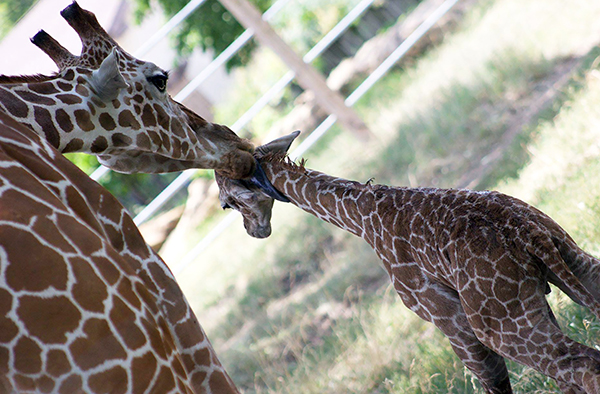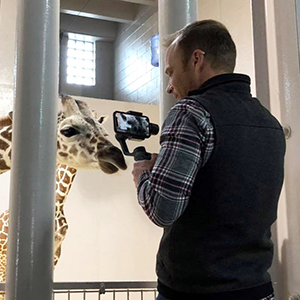Giraffe Chatter
Alumni team up to bring new digital content to KTWU, Topeka Zoo

From The Ichabod - Winter 2019
Gary Krohe and Jay Hurst graduated from Washburn University at completely different times but their technological skills came together with staff at KTWU and the Topeka Zoo to build new content for the public television station’s digital platforms.
What started as an idea to do short YouTube videos of the Topeka Zoo and Conservation Center’s animals turned into a multi-camera, 24-hour livestream of the zoo’s two pregnant giraffes and pregnant tiger produced by KTWU, a public television station licensed by Washburn University and located on campus.
After Krohe, ba ’76, director of engineering and technology with KTWU, earned his degree in communications, he went into engineering for television stations across the U.S. He built Topeka channel 49 KTKA from the ground up and then went on to consulting work. Despite going into engineering, he said his degree in communications helped him understand how technology needed to be used.
Fast forward a few decades and Hurst, bba ’10, assistant producer with KTWU, was learning about live shots when he was helping the Information Technology Services department broadcast Washburn basketball games online. Live video was in demand due to increased use of social media.
Their talents – Krohe’s engineering and Hurst’s camera work – combined to increase the digital presence of KTWU and the Topeka Zoo’s brand.
“I knew what had been done in New York with April the giraffe, and I knew we could do better,” said Krohe, who volunteered for KTWU before becoming an employee in 2014.
Announced in May 2018, the initial live shot had its problems – the camera was crashing every few minutes as more people were watching. It led Krohe and Mark Flynn, assistant chief engineer at KTWU, to build an infrastructure that included a microwave tower on top of the Animals and Man building, which sent the signal to a new and higher microwave unit on KTWU’s satellite more than five miles away. This resulted in a stronger signal so thousands of people could watch the giraffes give birth live.
“I think one of the things that makes these cameras different is the infrastructure that supports it,” said Brendan Wiley, director of the Topeka Zoo. “We could have never afforded to do it on our own. The partnership with KTWU is truly what made that happen. It’s not cheap, and we are hoping to find a way to continue to fund the operation.”
The stable livestream brought in a stable audience – affectionately called giraffe chatters by the KTWU and zoo staff - who watched patiently and talked to each other for weeks before the first baby giraffe made its way into the world. Frances Wadsworth, aa ’15, continues to monitor the chat for KTWU and keeps them engaged.
What made this livestream special was four cameras that could zoom, pan and tilt – all controlled remotely from Krohe’s computer. The viewing experience brought people in from all around the world who watched and donated to the zoo and KTWU as well as offered advice on what they have seen at other zoos.
“It has brought a lot of awareness about our zoo, the quality of animal care we have here, and it has allowed us to have a louder voice around the country,” Wiley said. “It has also allowed us to raise funds for enrichment toys for various animals and put in modifications for our bull giraffe for our giraffe habitat.”
 KTWU has been looking for opportunities like this to drive more people to its digital platforms. When Val VanDerSluis, director of programing, content and social media at KTWU, recently met with colleagues across the nation, she said KTWU was the only one doing partnerships like this with their local zoo.
KTWU has been looking for opportunities like this to drive more people to its digital platforms. When Val VanDerSluis, director of programing, content and social media at KTWU, recently met with colleagues across the nation, she said KTWU was the only one doing partnerships like this with their local zoo.
YouTube, especially among the younger generation, is where people are going today to find content. Hurst said children are watching short clips one after the other instead of sitting down and watching a full 30-minute or one-hour show. Short YouTube videos or live shots where people can go back and forth are drawing viewers.
“If we can be visible and have a good audience on YouTube and other digital platforms, we can stay alive as public television,” Hurst said.
VanDerSluis said KTWU is focused on keeping the partnership going. They added two cameras when the zoo’s tiger had four cubs this past fall, but they plan to keep the cameras moving around the zoo to draw in new viewers and to give the zookeepers a break.
"Not only are giraffes and tigers watched regularly, but also the zookeepers," she said. "Their jobs are constantly scrutinized, as they are now featured on what you could pretty well classify as a reality show. Many viewers comment and critique on the work done by zookeepers and at some point the cameras need to be moved to give them a break and allow them to do their jobs."